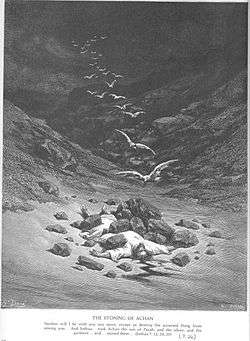Achan (biblical figure)

Achan (/ˈeɪkæn/; Hebrew: עכן), the son of Carmi, the son of Zabdi, the son of Zerah, of the tribe of Judah, is a figure who appears in the Book of Joshua in the Hebrew Bible in connection with the fall of Jericho and conquest of Ai.
His name is given as Achar in 1 Chronicles 2:7.
Account in the Book of Joshua
According to the narrative of Joshua chapter 7, Achan pillaged an ingot of gold, a quantity of silver, and a "beautiful Babylonian garment" from Jericho, in contravention of God's directive that "all the silver, and gold, and vessels of brass and iron, are consecrated unto the Lord: they shall come into the treasury of the Lord" (Joshua 6:19).
Although the account suggests that Achan personally was guilty of coveting and taking these spoils, the chapter opens with a statement that the whole community of "the children of Israel [had] committed a trespass" (Joshua 7:1).
The Book of Joshua claims that this act resulted in the Israelites being collectively punished by God, in that they failed in their first attempt to capture Ai, with about 36 Israelite lives lost (Joshua 7:5). The Israelites used cleromancy to decide who was to blame, and having identified Achan, stoned him, as well as his sheep, other livestock and his children to death. Their remains were burnt by the Israelites, according to the text, and stones piled on top.
Interpretation
Rashi, and many opinions in the Talmud, argue that the stoning was only carried out on the livestock and Achan himself, and that his children were merely brought forward to witness the Israelites ... stone them (Biblical text with emphasis added). The Talmud writers do, however, admit the possibility of the children being also stoned, arguing that since they had kept silent about their father's actions, they were complicit in the crime. One tradition, seemingly older, that is reported by the Classical Rabbinical literature, states that Achan's crime was far worse than the Biblical account appears—Achan had, according to these Rabbis, also stolen a magic idol with a golden tongue, silver votive gifts dedicated to it, and the expensive cloth that covered it. Other classical Rabbis portray Achan as guilty of more earthly crimes, claiming that he had committed incest, or performed work on the sabbath (equally immoral in their eyes).
In the narrative, before Achan is stoned to death, he first confesses his actions, which the Classical Rabbis argued would have saved him from Gehenna (the classical-era Jewish conception of hell). From a textual point of view, it exonerates the Israelites from any question of condemning a man without evidence other than cleromancy, and thus avoids questions over the validity of supernatural tests of guilt.
The narrative states that the location for this punishment of Achan, which lies between Jericho and Ai, became known as the vale of Achor in memory of him. This narrative is seen by some biblical scholars as an etiological myth providing a folk etymology for Achor, at the point in the narrative where the vale of Achor is necessarily crossed.
One item to note however is that the text describes the garment that Achor stole as Babylonish; the time of the Israelite invasion is usually dated to the 15th or 12th centuries BC, but between 1595BC and 627BC Babylon was under foreign rule. For this reason, a few textual scholars believe that this part of the Achor narrative was written during the 7th century BC or later, but many Biblical scholars believe the judge Samuel may have put together this account from historical books from that time. It is not certain, however, that the whole Achor narrative dates from this time, as textual critics believe that the Achor narrative may have been spliced together from two earlier source texts; the words in the first part of Joshua 7:25, all Israel stoned him with stones (emphasis added) show a different style and tradition from those at the end of the verse: they stoned them with stones (emphasis added).[1]
Notes
References
 This article incorporates text from a publication now in the public domain: Singer, Isidore; et al., eds. (1901–1906). "Achan". Jewish Encyclopedia. New York: Funk & Wagnalls Company.
This article incorporates text from a publication now in the public domain: Singer, Isidore; et al., eds. (1901–1906). "Achan". Jewish Encyclopedia. New York: Funk & Wagnalls Company. This article incorporates text from a publication now in the public domain: Easton, Matthew George (1897). "article name needed". Easton's Bible Dictionary (New and revised ed.). T. Nelson and Sons.
This article incorporates text from a publication now in the public domain: Easton, Matthew George (1897). "article name needed". Easton's Bible Dictionary (New and revised ed.). T. Nelson and Sons.